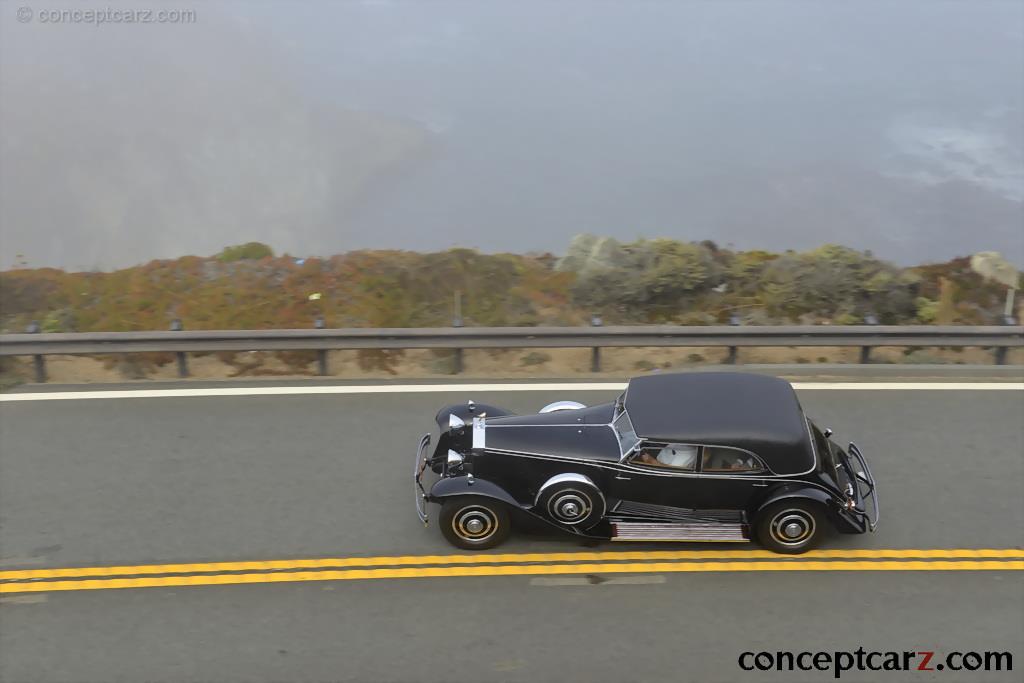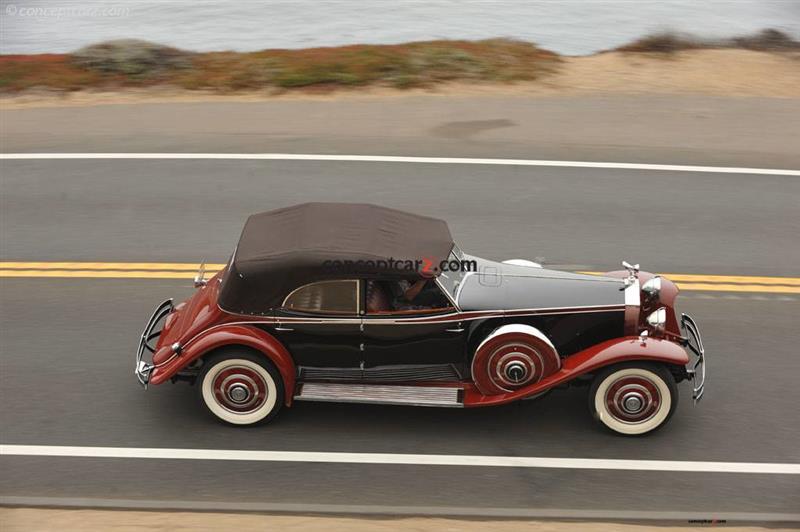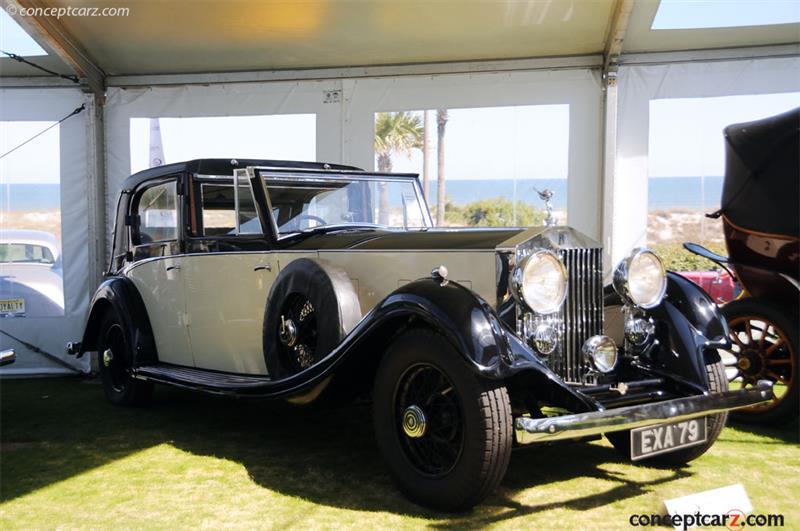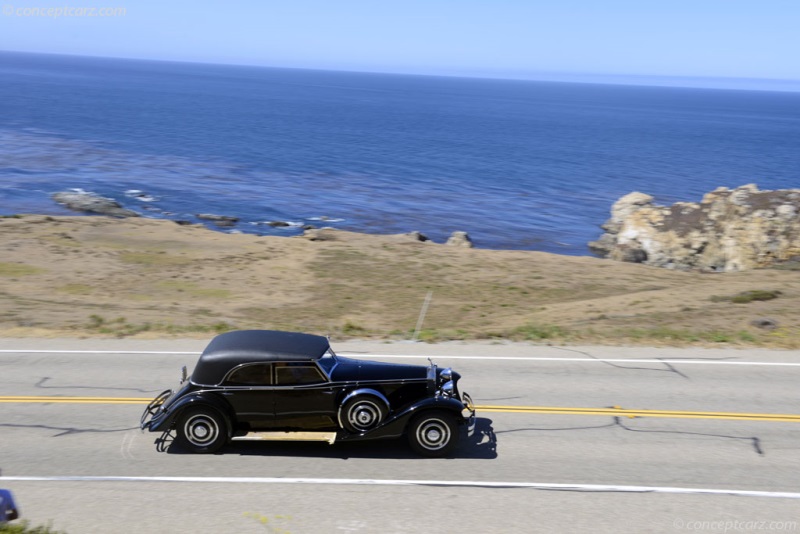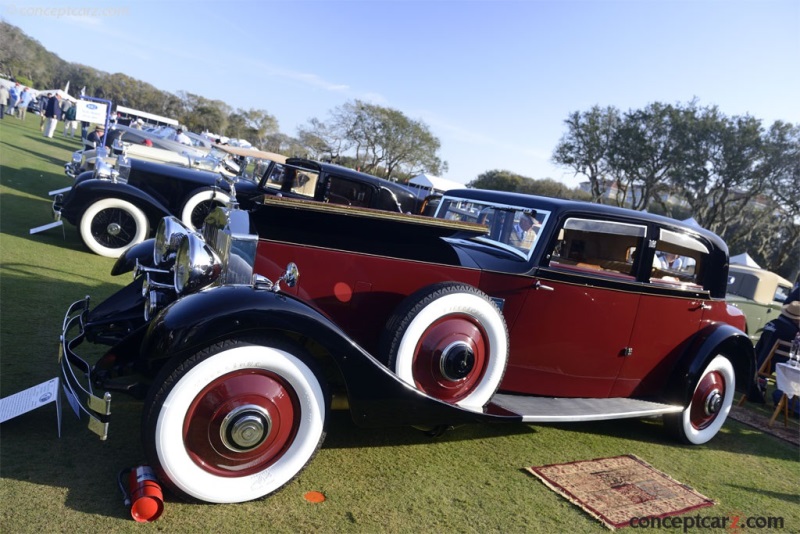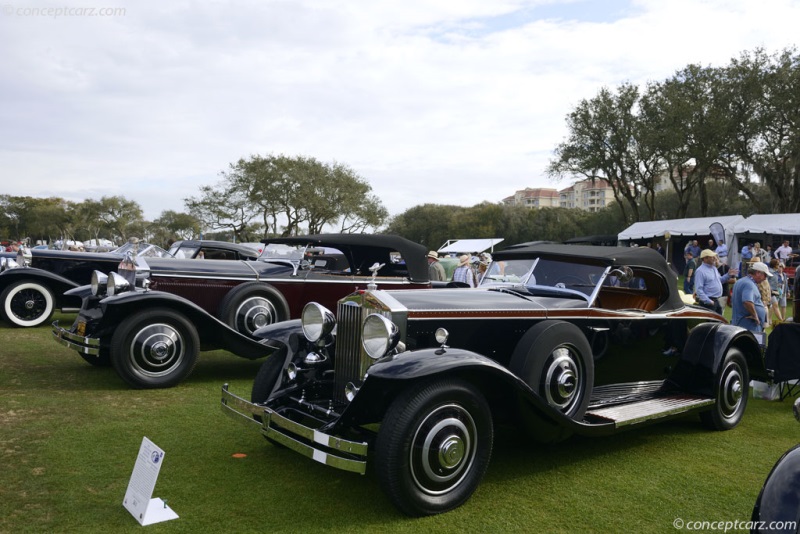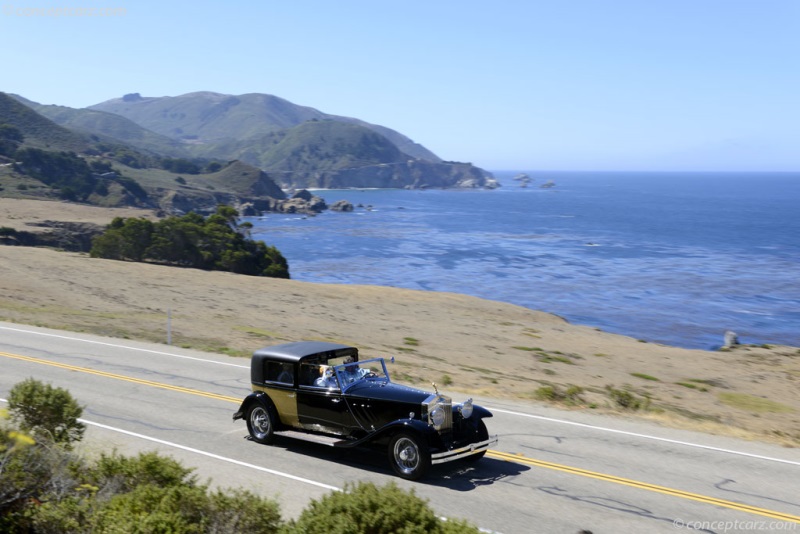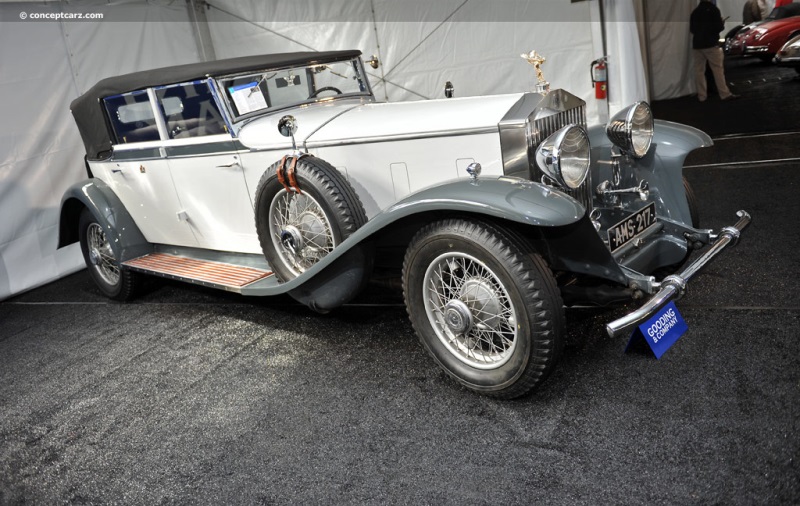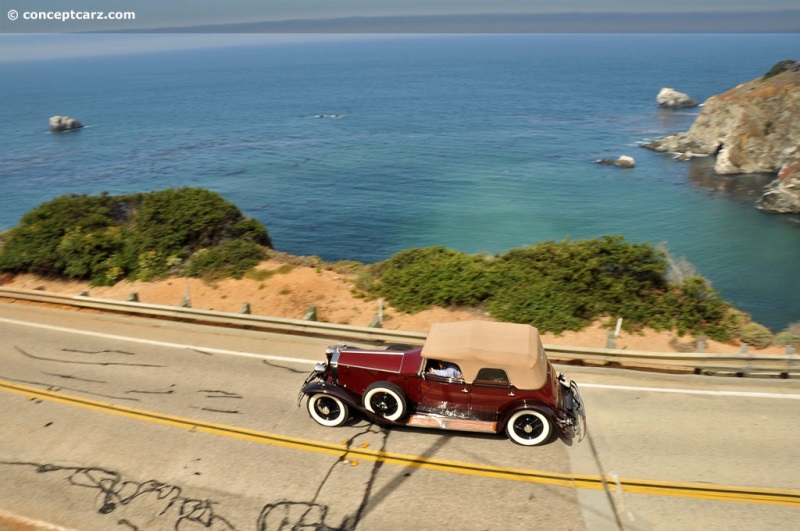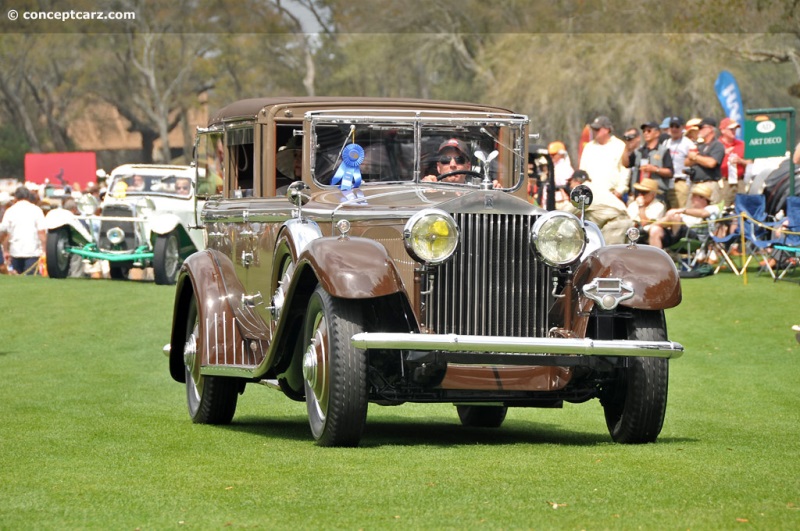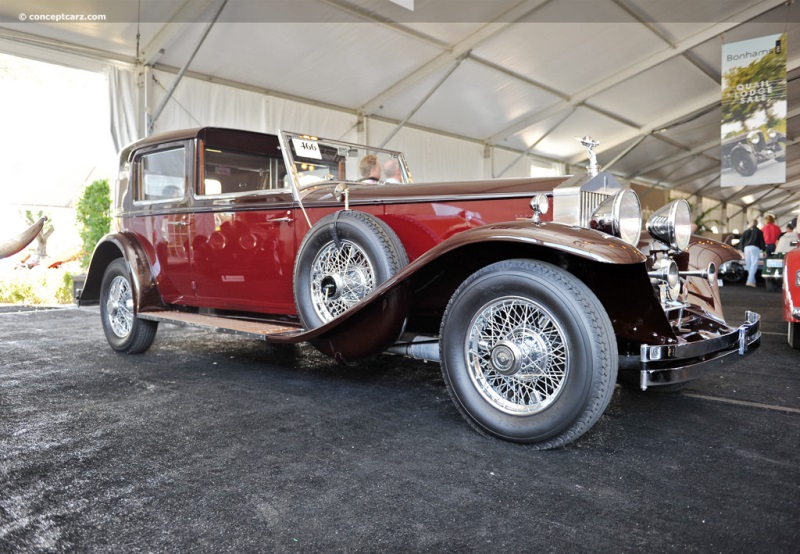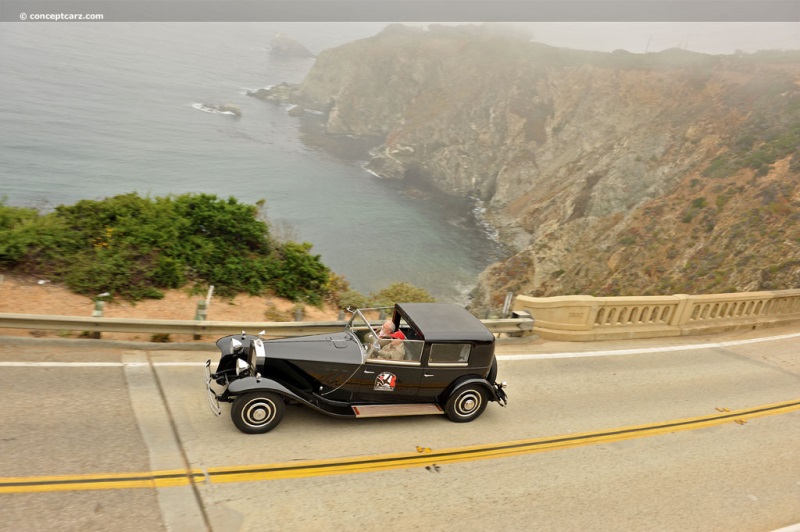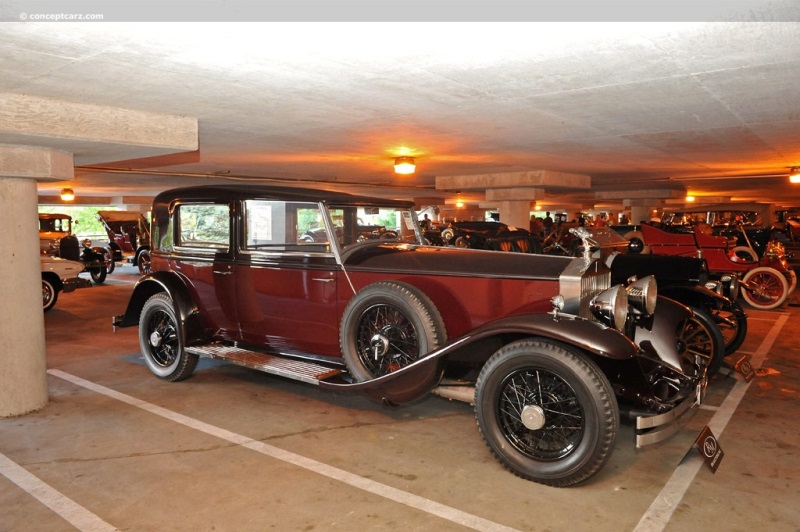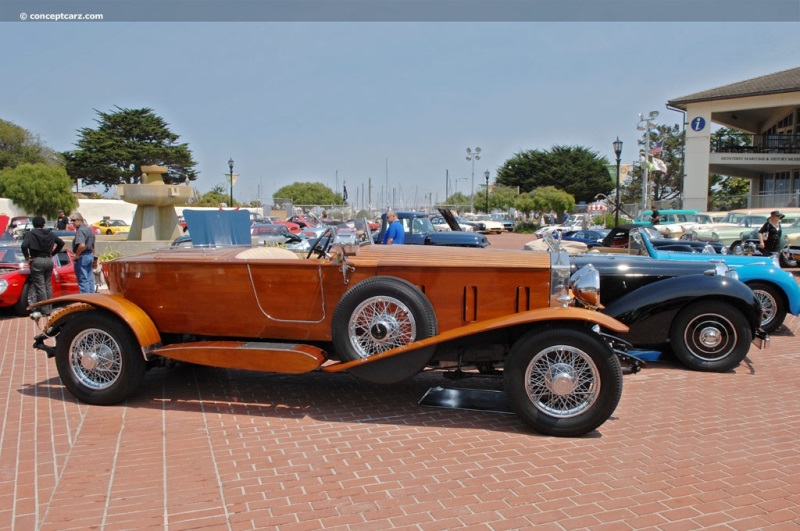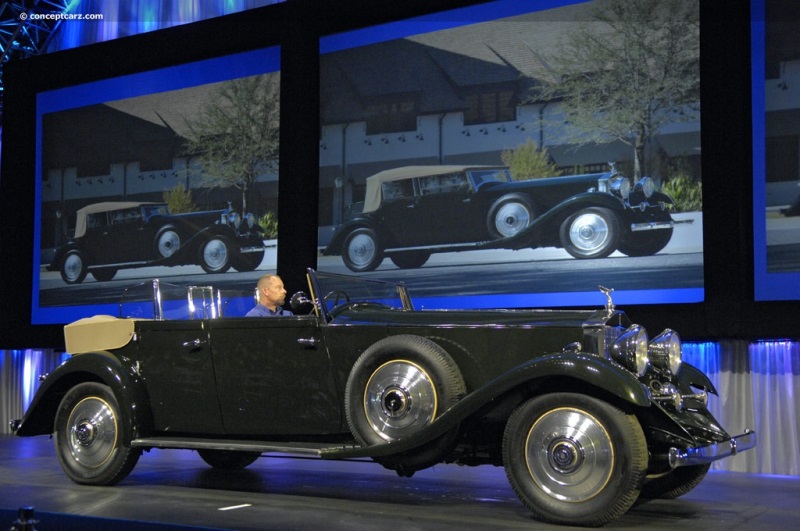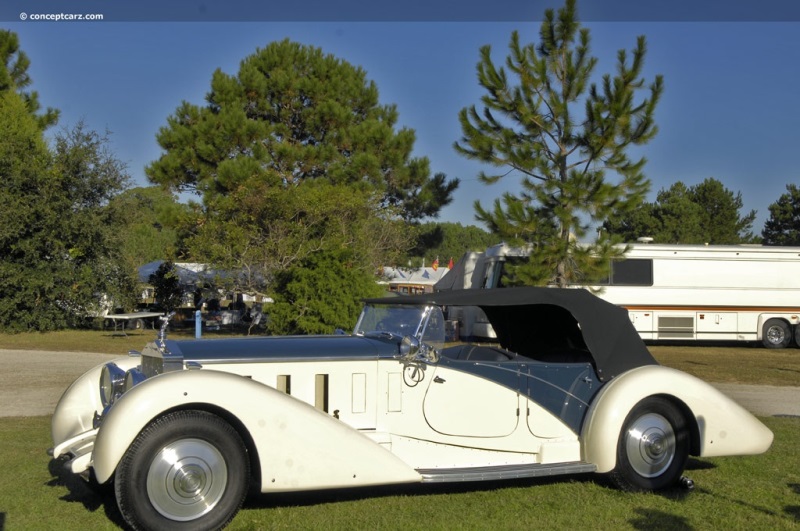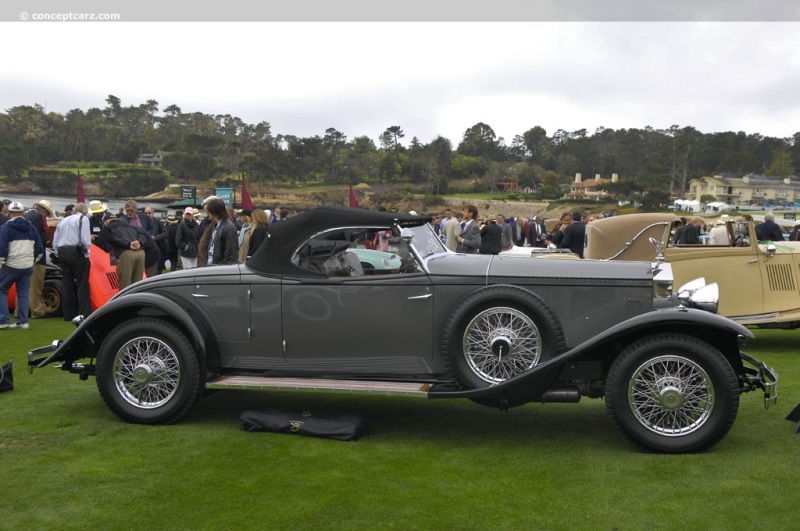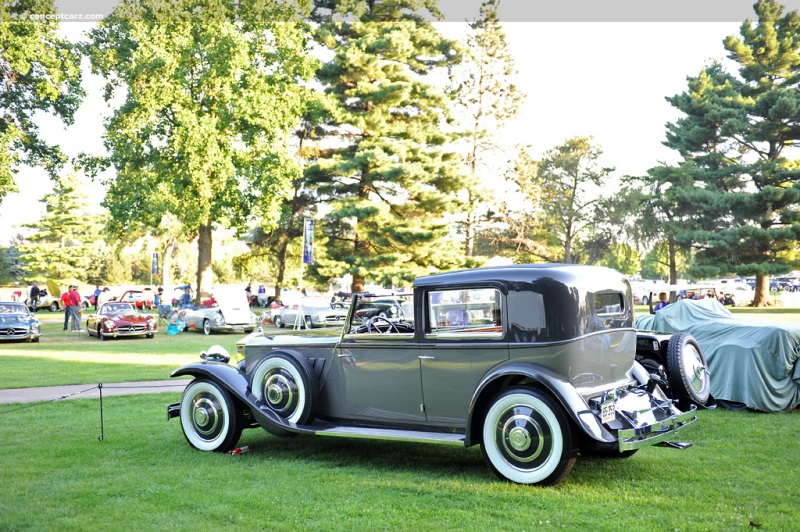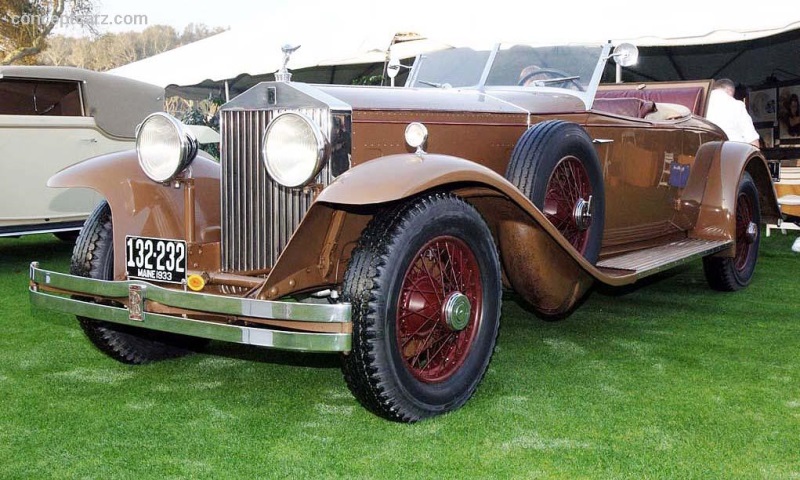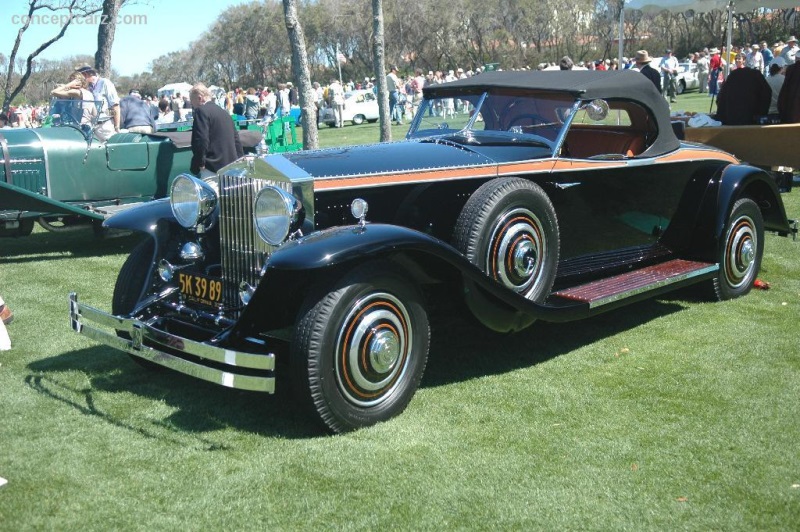1933 Rolls-Royce Phantom II Navigation
The Rolls-Royce Phantom II was introduced in 1929 and incorporated numerous improvements over its predecessor, the Phantom I. It rested on a completely new chassis with the front axle mounted on semi-elliptical leaf springs and the rear axle also using semi-elliptical springs, replacing the older styled cantilever springs. These changes allowed the frame to sit lower resulting in dramatic improvements in handling. The radiator was positioned back behind the front axle and the steering was more than half of the way back in the wheelbase. The well-proportioned chassis still managed to carry a long hood and was a favorite of the best coachbuilders of the day including Hooper, Mulliner, Park Ward, and Thrupp & Maberly. All bodybuilders of Rolls-Royce cars, regardless of being in the U.S. or U.K., were required to supply their designs to Rolls-Royce for approval. After the body was fitted to the chassis, the coachbuilder returned the car to Rolls-Royce for testing and final inspection prior to delivery to the customer. 
Henley Roadster by Brewster
View info and historyOn the U.S. side, Rolls-Royce had ceased production at its Springfield, Massachusetts plant in 1931, after building 2,944 motorcars there. Rolls-Royce had produced the Silver Ghost and the New Phantom at both Rolls-Royces' Derby factory in the United Kingdom and at a factory in Springfield, Massachusetts. New Phantom (Phantom I) production at the U.S. factory lasted from 1926 to 1931. The main differences between the U.K. and U.S. models were the transmission and wheelbase sizes. Both had a standard wheelbase of 143.5-inches, while the long-wheelbase U.S. version measured 146.5-inches and the U.K. at 150.5-inches. Both versions came with a single dry-plate clutch, while the UK had a 4-speed and the U.S. a center change 3-speed unit. Other differences include the U.S. models using a centralized Bijur system while the U.K. models employed Enot nipples. The fuel gauge placement was sometimes different, with the U.S. models occasionally being placed on the dash instead of the tank. The radiator shutters of the U.S. cars were thermostatically controlled to open or shut depending upon engine temperature, and manual control of extra cylinder lubrication was fitted for cold starts. U.S.-destined cars had front and rear bumper supports, heavier rear brake drums, wider brake shoes, and higher gear ratios for high-speed touring. After being tested at the Rolls-Royce Works in Derby, England, they were shipped to the United States Customs at the Port of New York. To reduce Atlantic-crossing shipping costs, the Phantom II 'A' chassis were sent without a horn, chassis lubrication fittings, spring gaiters, tool kit, spark plus, and hood locks. American-sourced parts were installed upon the chassis arrival. Rolls-Royce produced 2,269 examples of the New Phantom (Phantom I) in the United Kingdom and 1,240 examples in the United States. Production of the Phantom II lasted from 1929 through 1936 with 1,680 produced. 278 of those were Phantom II Continentals. All of the chassis were built at Rolls-Royce's factory in Derby, including two US-market series, the AJS and AMS. The 'A' in 'AJS' or 'AMS' represented a car modified for the American market. The most visual change was the conversion from right-hand to left-hand drive, with the American-type central gearshift replacing the British-style side lever. The bodies were made and fitted by coachbuilders, including Rolls-Royce's Brewster Coachworks. 116 cars were sent to the United States to be clothed by Brewster. The Phantom II 'Continental' was birthed from a special order by Mr. Royce who commissioned designer H.I.F. 'Ivan' Evernden to build a one-off Phantom on a short-wheelbase. It received modifications to the engine and suspension, and wore a lightweight close-coupled saloon body built by Barker. Upgrades to the engine include a higher-lift camshaft and increased compression, and a taller rear-axle ratio. The suspension received flatter springs for a lower stance, twin Hartford auxiliary dampers in the front for ride control, and a raked steering column. It was known as 26EX and shown at the 1930 Biarritz Grand Concours d'Elegance. Although there were no plans to put 26EX into production, its Grand Prix d'Honneur victory at the Biarritz Grand Concours and immediate enthusiasm for the model sparked its creation. Two hundred and eighty-one examples were ultimately produced with 125 equipped with left-hand drive.
Freestone & Webb Sedanca de Ville by Freestone & Webb
Chassis #: 115TA
View info and history
Auction entries : 1Following the initial intention of 26EX, the Phantom II Continental production versions were built for high-speed touring and used a shortened chassis, with revised suspension and specially tuned engine. The 7,668cc overhead-valve inline six-cylinder engine breathed through a single Rolls-Royce carburetor and developed 120 horsepower at 3,500 RPM. They were backed by a four-speed manual gearbox with braking handled by four-wheel mechanical drum brakes with servo assist. The suspension was comprised of solid axles, semi-elliptical leaf springs, shock absorbers, and hydraulic dampers. The Phantom II Continental was capable of nearly 100 mph. They were pricier, sportier, and with fewer examples produced - rarer.The Phantom II was the final Rolls-Royce designed by the company co-founder Mr. Henry Royce who passed away on April 22nd of 1933. It used many of the lessons learned from the 'New Phantom,' now commonly known as the Phantom I, and employing the same six-cylinder pushrod overhead valve engine but with a new cross-flow cylinder head, new combustion chambers, and improved manifolds. Initially, it produced 120 horsepower but subsequent developments resulted in over 150 horsepower in some cases. The engine, clutch, and the four-speed transmission were now a single unit with an open driveshaft. Later changes included synchromesh on the top two gears.Brewster & Company
The Brewster & Company was located on Long Island, New York, and founded in 1810. With facilities in England, they won a Gold Medal at the Paris Exposition in 1878 for a horse-drawn carriage. They began building bodies for motor vehicles in 1950 and in 1908, mounted a landaulette on a Silver Ghost chassis. In 1925, the Brewster Company was acquired by Rolls-Royce of America. In 1931, they began designing and fitting bodies to the left-hand drive imported Phantom IIs. Nearly every Rolls-Royce that left the Springfield facility during the last five years of its existence wore a body by Brewster.
by Daniel Vaughan | Jun 2020
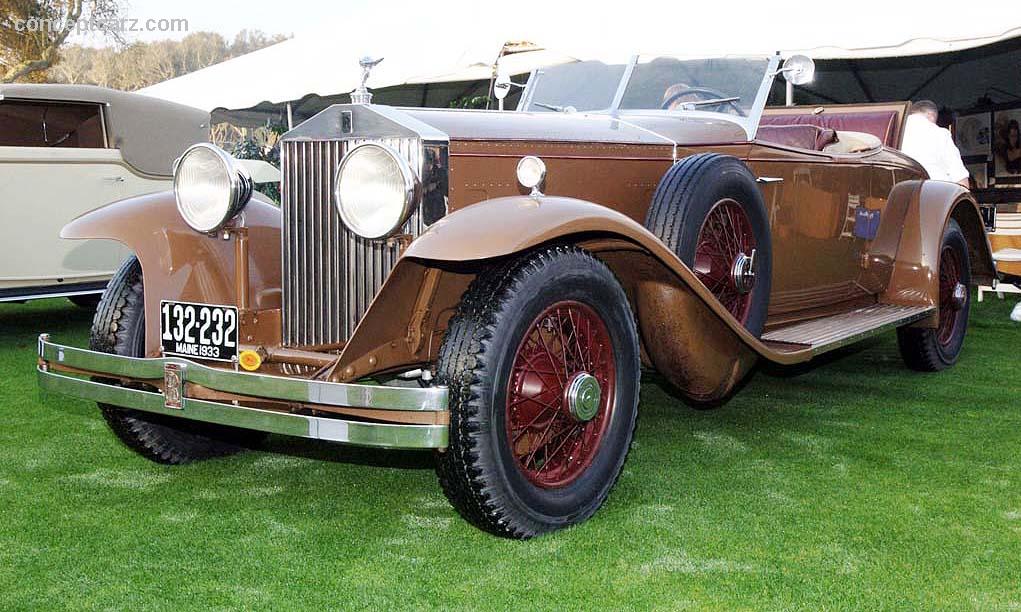
Henley Roadster by Brewster
View info and history
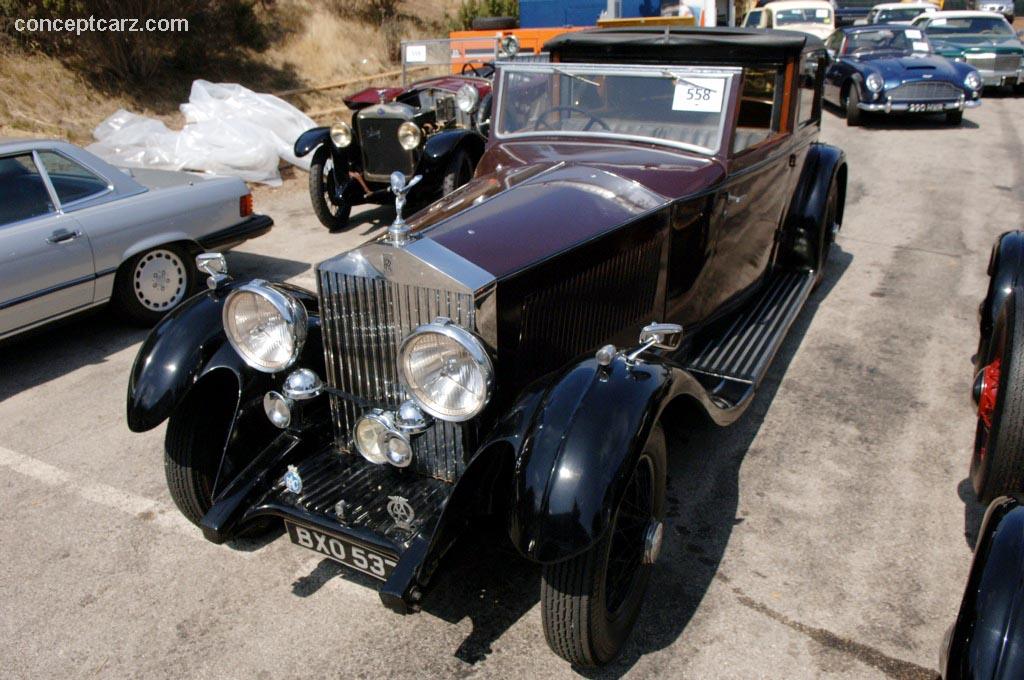
Freestone & Webb Sedanca de Ville by Freestone & Webb
Chassis #: 115TA
View info and history
Auction entries : 1
The Brewster & Company was located on Long Island, New York, and founded in 1810. With facilities in England, they won a Gold Medal at the Paris Exposition in 1878 for a horse-drawn carriage. They began building bodies for motor vehicles in 1950 and in 1908, mounted a landaulette on a Silver Ghost chassis. In 1925, the Brewster Company was acquired by Rolls-Royce of America. In 1931, they began designing and fitting bodies to the left-hand drive imported Phantom IIs. Nearly every Rolls-Royce that left the Springfield facility during the last five years of its existence wore a body by Brewster.
by Daniel Vaughan | Jun 2020
Related Reading : Rolls-Royce Phantom II / Phantom II Continental History
The Phantom II was the first completely new car since the 20HP seven years earlier. The Phantom II was still rated 4050 HP but was lower and the springing half-elliptic all around. The car, although to Royces design and specification, was mainly the work of his West Wittering design team and included many innovations and a redesigned engine that, with the gearbox, was now one unit. The introduction....
Continue Reading >>
Continue Reading >>
Related Reading : Rolls-Royce Phantom II / Phantom II Continental History
The Rolls-Royce Phantom II was very similar to the Phantom I in many ways, but brought improvements such as a higher horsepower rating and the removal of the traditional torque-tube drive. Instead, the engine and gearbox were constructed in unit with each other rather than being separate. The Autovac was now using an engine-driven pump. A new water-heated induction system was used. The Battery....
Continue Reading >>
Continue Reading >>
- 1933 Rolls-Royce Phantom II Menu
- Article
- Image gallery
- Valuation
- Specifications
- Profiles
- Production figures
Rolls-Royce
Similar Automakers
Similarly Sized Vehicles
from 1933
1933 Rolls-Royce Phantom II Vehicle Profiles
Recent Vehicle Additions
Performance and Specification Comparison
Phantom II / Phantom II Continental Specification Comparison by Year
Year
Production
Wheelbase
Engine
Prices
144.00 in., 150.00 in.
6 cyl., 467.93 CID., 108.00hp
6 cyl., 467.93 CID., 120.00hp
6 cyl., 467.93 CID., 120.00hp
$9,500 - $9,500
Related Automotive News

Past Best of Show Winners at The Pebble Beach Concours d'Elegance
overview1
The 70th anniversary of the Pebble Beach Concours dElegance was celebrated with a spectacular display of previous Best of Show winners. Thirty-seven examples graced the showfield and many were still with the same owners who raised the trophy...

Mercedes-Benz EQC 4Matic UK Pricing And Specification Announced
Prices start at £65,640 OTR for the EQC 400 4MATIC Sport Four trim lines available Sport, AMG Line, AMG Line Premium and AMG Line Premium Plus Two special editions available Edition 1 and Edition 1886 On sale...

Alfa Romeo Named Best of Show at the 68th Pebble Beach Concours d'Elegance
Touring-Bodied Alfa Romeo 8C 2900B Named Best of Show at the 68th Pebble Beach Concours dElegance
PEBBLE BEACH, Calif. (August 26, 2018) — After an intense competition that drew diverse cars from around the globe, the coveted gold Best of Show...

1929 Mercedes-Benz S Barker Tourer Named Best Of Show At The 67Th Pebble Beach Concours d'Elegance
PEBBLE BEACH, Calif. (August 20, 2017) — Just a week ago, Bruce R. McCaws 1929 Mercedes-Benz S Barker Tourer emerged from the restoration shop of Steve Babinsky in Lebanon, New Jersey. Today, having crossed the country, the boattailed beauty captured...

Lancia Named 2016 Best of Show
PEBBLE BEACH, Calif. (August 21, 2016) — The 2016 Pebble Beach Concours dElegance concluded with first-time entrant Richard Mattei lifting the top prize high overhead soon after his 1936 Lancia Astura Pinin Farina Cabriolet was named Best of...
